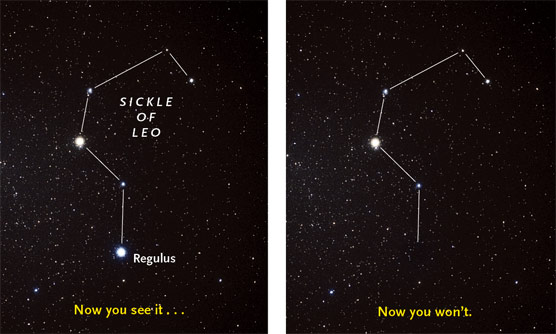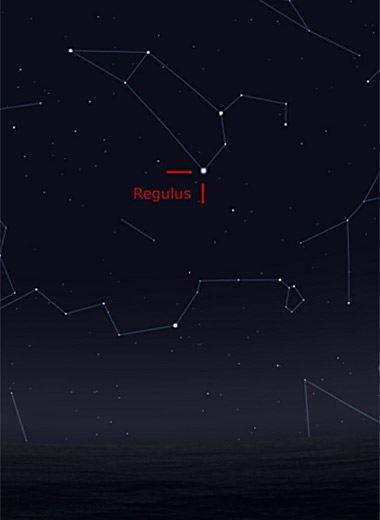March 13, 2014
Contact:
Alan MacRobert, Senior Editor, Sky & Telescope
855-638-5388 x2151, [email protected]
For high-quality versions of the graphics, click the images.
Millions of people around New York City and points north can plan to watch a faint asteroid dramatically black out a bright naked-eye star very late next Wednesday night (the night of March 19–20).
And if you're anywhere from the Carolinas to Nova Scotia to Winnipeg, a citizen-science project is asking you to keep watch too!

Regulus will vanish behind the asteroid 163 Erigone for several seconds on the morning of March 20, 2014, for well-placed skywatchers. Click image for larger view.
Akira Fujii / Sky & Telescope magazine
.
Get ready for the best and brightest "asteroid occultation" ever predicted for North America. Late on the night of March 19–20, the faint asteroid Erigone (eh-RIG-uh-nee) will briefly eclipse the bright naked-eye star Regulus for more than 20 million people in the New York metropolitan area and parts of Long Island, New Jersey, Connecticut, upstate New York, and Ontario. The star will vanish from sight for up to 14 seconds around 2:06 a.m. EDT on the morning of the 20th for New Yorkers, and a minute or two later farther north.

The predicted occultation path. The blue lines show the outer edges of the zone where Regulus will be blacked out if the prediction is perfect. Astronomers expect the prediction to be closely on target; the actual shadow path is almost sure to fall somewhere between the slightly wider uncertainty lines (within the red lines to 68% probability, within the gray lines to 95% probability). Click image for a Google Map view that can be zoomed to any size or resolution.
Geoff Hitchcox / IOTA / Google Maps
.
If the sky is clear, Regulus will be a cinch for anyone to spot — no astronomy experience required! Around 2 a.m. or a bit before, go out and face the Moon. Extend your arms straight out to your sides. Regulus will be straight above your right hand, roughly as high as the Moon is. It's the brightest star in that area.

Looking southwest (90° to the right of the Moon) around 2 a.m. EDT on the morning of March 20th. Regulus will appear roughly as high as the Moon. It's the brightest star in the area; you don't need to know, or see, the constellations! Click image for larger view.
IOTA / Stellarium / Sky & Telescope
"Regulus shines right through moonlight and light pollution that's in the sky — even the light pollution over a city like New York," says Alan MacRobert, a senior editor at Sky & Telescope magazine. "Just be sure to shield your eyes against any glary lights, and Regulus should be easy to find."
Think of it as a space-rock eclipse of a star. Astronomers use the term occultation for these events, from the Latin word for "hide."
Says MacRobert, "I've been using a telescope to go after asteroid occultations of really faint stars for ages. I never thought we'd get one in my life for a star this bright and easy."
In fact, this is the first time in history that an occultation of such a bright star by an asteroid has been predicted to cross such a heavily populated area.
Citizen Scientists Wanted
But this is more than a chance to watch a moment of rare celestial drama. Asteroid occultation timers — an elite specialty crowd among amateur astronomers — hope to enlist thousands of everyday folks in a citizen-science project to document this event more thoroughly than any asteroid occultation has been before. You can participate with just your eyes, or with a DSLR camera in movie mode, or with better gear if you're into serious astronomy stuff.
This effort is being spearheaded by the International Occultation Timing Association (IOTA). Its website for the public telling all about the event and how to participate is occultations.org/Regulus2014.
The goal is to see (1) whether the star disappears as seen from your location, and (2) for how long — especially if you can time the event to high precision. Read full details and instructions at the website.
From this data, astronomers hope to obtain a very precise profile of Erigone's size and shape, something that cannot be done any other way short of sending a spacecraft there. This has been done for many asteroids in the past that have occulted fainter stars.

Two past successes. The double asteroid Antiope and big, roundish Interamnia blotted out faint background stars on July 19, 2011, and March 23, 2003, respectively. In each case, dozens of observers scattered across hundreds of miles set up equipment to time the star's disappearance and reappearance. Each yellow line represents one observer watching the star. Accurate timings of when the star vanished and returned (breaks in the yellow line) can be properly fitted with each other to yield the asteroid's actual silhouette. Or for Antiope, two silhouettes! Click image for larger version.
International Occultation Timing Assn. / Sky & Telescope
.
Where and When
The map at the top of this page shows the predicted path of the Regulus-shadow that Erigone will cast. The blue lines show where the edges of the shadow will travel if the prediction is perfect. Astronomers expect the prediction to be closely on target; the actual shadow path is almost sure to fall somewhere within the outer uncertainty lines.
Similarly, the following predicted times should be off by no more than a minute: 2:06 a.m. for the New York City region, 2:07 where the path runs through central upstate New York, and 2:08 a.m. where it goes north of Lake Ontario. The shadow will be moving at 11,400 miles per hour.
The shadow path is roughly as wide as Erigone itself, an irregular object about 45 miles across that's orbiting the Sun in the asteroid belt. It's currently 110 million miles from Earth. It's so small and far that it appears 26,000 times fainter than Regulus (that is, magnitude 12.4), so it will be completely invisible in the bright star's glare even with a large telescope.
“A major star winking out like this? It's worth catching if you can," says Sky & Telescope assistant editor Camille Carlisle. She'll be traveling to watch the event with friends in upstate New York.
Not near the path? You're wanted too!
People anywhere from the Carolinas to Nova Scotia to Winnipeg are also encouraged to watch Regulus during the critical minutes and report whether or not it vanishes, and when. The reason? Erigone might have a satellite asteroid accompanying it! Some asteroids do. A "secondary occultation" crossing different territory would reveal such a satellite if it exists. Whether you're near or far from the path, watch steadily from at least 2:00 to 2:12 a.m. EDT for a chance at catching the star being eclipsed by a second, unknown object. (In the Central time zone: 1:00 to 1:12 a.m. CDT).
For more about this exciting event, see the March issue of Sky & Telescope, the essential guide to astronomy since 1941. Or visit its website at SkyandTelescope.com.
Sky & Telescope (an F+W Media magazine) was founded in 1941 by Charles A. Federer Jr. and Helen Spence Federer, its original editors. In addition to Sky & Telescope and SkyandTelescope.com, it publishes two annuals (Beautiful Universe and SkyWatch), as well as books, star atlases, posters, prints, globes, and other fine astronomy products.
 0
0
Comments
You must be logged in to post a comment.